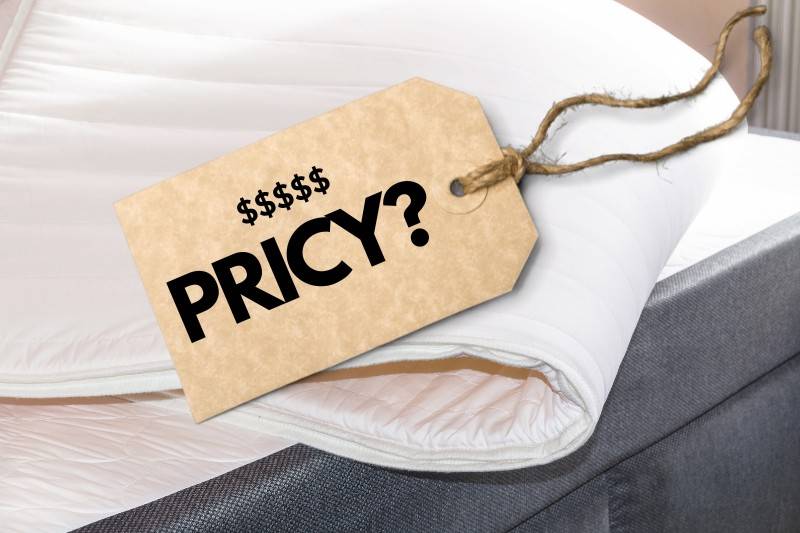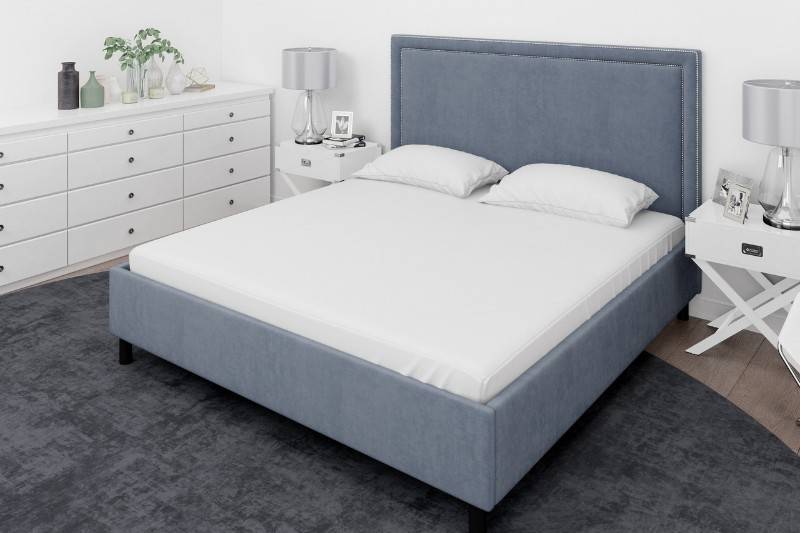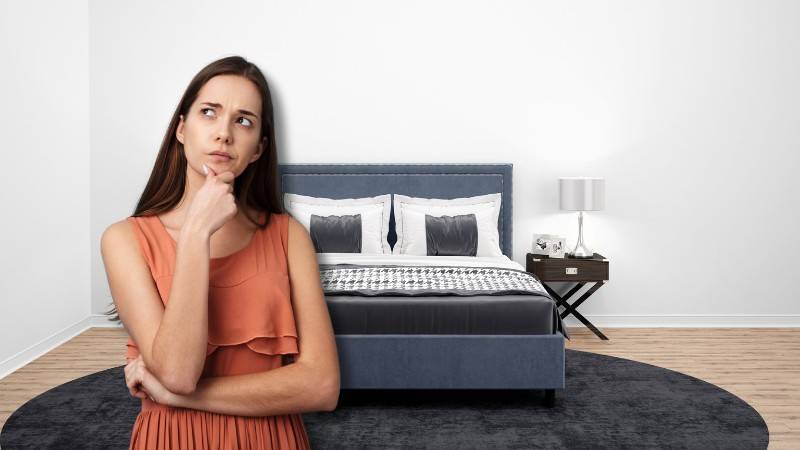Are you in the market for a new mattress and wondering if you also need to pick up a box spring? It’s a common question, and the simple answer is probably not. Let me explain why.
Mattresses have evolved over time, embracing materials like memory foam, latex, and a mix of both (hybrid mattresses). With these advancements, the traditional box spring isn’t your only option anymore. Modern platform beds, available in various sizes and designs, offer a solid alternative.
Let’s talk about box springs for a minute.
Imagine a sturdy, fabric-covered wooden frame almost the same size as your mattress, housing a network of metal springs or a metal grid. This setup is designed to support your mattress, ensuring it stays flat and stable. The springs also play a crucial role in absorbing movement, which can prolong the life of your mattress and promote better airflow.
But here’s the twist: Box springs were originally made with innerspring mattresses in mind. If you’re leaning towards a memory foam mattress, a platform bed with wooden slats might be a better match. These beds are designed to offer firm, even support, which memory foam mattresses love.
So, do you really need a box spring?
It boils down to the type of mattress you choose and the bed frame you have at home. The best way to know for sure is to check with your mattress manufacturer. They can guide you on whether your mattress and a box spring are a match made in heaven or if you should consider a different type of support.
Who Should And Shouldn’t Get a Box Spring?
Wondering if you should team up your mattress with a box spring? It’s a question many face, and the answer isn’t one-size-fits-all.
It mostly comes down to your mattress type, bed frame, and personal preferences.
Let’s peek into who might need a box spring and who might not.
Who Might Need a Box Spring?
- Traditional Bed Frame Owners: If you have one of those classic metal rail bed frames, a box spring fits perfectly. It’s made to nestle right in.
- Older Innerspring Mattress Owners: Got an innerspring mattress? It’s likely designed to buddy up with a box spring for that perfect balance and support.
- Manufacturer’s Advice: If your mattress maker recommends a box spring, it’s wise to follow that advice for the best sleep and to keep your warranty intact.
- Height Seekers: Love a tall bed that’s easy to hop in and out of? A box spring can add that extra height, though there are other ways to lift your bed too.
Who Might Not Need a Box Spring?
- Modern Mattress Owners: Rocking a memory foam, latex, or hybrid mattress? These contemporary designs often vibe better with solid, flat surfaces rather than box springs.
- Platform Bed Fans: If you’re all about that sleek platform bed or a sturdy wood foundation, you might not need a box spring. These bed types are designed to support your mattress solo.
- Floor Sleepers: Prefer your mattress right on the floor? That’s a clear no-box-spring zone.
If you’re exploring alternatives to box springs, why not consider platform beds or wood slat foundations? They’ve gained popularity for a reason – offering style, functionality, and the right kind of support for a variety of mattresses.
Remember, using the wrong foundation for your mattress might not just lead to a less-than-ideal sleep experience; it could also damage your mattress and make that warranty void.
In my own experience, making the switch from a box spring to a platform bed was a game-changer. Not only did it modernize the look of my bedroom, but it also offered the perfect support for my memory foam mattress.
So, take a moment to weigh your options, consult the experts, and choose the best foundation for your peaceful slumber.
What Is A Box Spring? The Purpose of a Box Spring
What exactly is a box spring, you ask?
Picture this: a sturdy foundation that’s the perfect twin in size to your mattress. It’s traditionally crafted from a wooden or metal frame housing springs and is neatly dressed in fabric. This trusty companion sits snugly under your mattress, offering a solid base of support.
So, what purpose does a box spring serve?
- Solid Support: It's like the best kind of friend for your mattress, holding it up and providing a steady base.
- Height Boost: Not a fan of low beds? A box spring adds a few inches, making it easier to slide in and out of bed.
- Mattress Shield: Think of it as a buffer, taking on wear and tear and safeguarding your mattress by soaking up impact.
- Cooling Factor: A box spring allows air to circulate under the mattress, keeping your sleep zone cool and comfy.
While box springs and innerspring mattresses go together like peanut butter and jelly, foam mattresses need a different kind of partner. They prefer a solid base, like a platform bed, to keep their shape and integrity intact.
When we talk about “box springs,” we’re harking back to the classic design featuring actual springs or a metal grid, all encased in a sturdy frame. But keep in mind that even box springs have a shelf life.
If you start noticing creaks, cracks, or sagging, it’s probably time for a fresh start.
On average, a box spring will stay in tip-top shape for about 10 years. And if you’re treating yourself to a new mattress, it’s wise to consider if your box spring still makes the cut.
How Much Does a Box Spring Cost?

Picking the right support for your mattress is crucial, but how much should you set aside for it?
The price tag isn’t one-size-fits-all; it swings based on several elements, just like when you’re shopping for a mattress.
Let’s understand what might bump up your bill:
- Size Matters: Bigger usually means pricier when it comes to box springs. A king-size will naturally cost more than a twin because, well, there's more of it.
- Material Quality: What your box spring is made of can push the price up or down. High-quality materials like sturdy wood or robust metal tend to notch up the cost compared to more budget-friendly synthetic options.
- Brand Power: Brand names can make a difference too. A well-known brand might charge a premium, while a less famous name might offer a more wallet-friendly option.
- Extra Features: Some box springs come with special add-ons, like adjustable legs to customize the height. Fancy features like these can add a few extra dollars to your bill.
To give you a clearer picture, here’s a quick rundown of what you might expect to pay for a box spring, based on size:
| Box Spring Type | Low-end Price | High-end Price | Average Price |
|---|---|---|---|
| Twin | $50 | $500 | $100 |
| Full | $60 | $600 | $150 |
| Queen | $70 | $800 | $200 |
| King | $90 | $800 | $300 |
| Split-King | $100 | $900 | $400 |
| California King | $110 | $1,000 | $500 |
While these are ballpark figures, the average cost for a box spring hovers around $250. Remember, it’s all about finding the right balance between what you need, the quality you’re after, and the budget you have in mind.
Box Springs Alternatives You Can Consider

Looking for alternatives to the traditional box spring?
You’re in luck!
There’s a variety of options out there, catering to every mattress type and personal preference. These are some of the popular choices:
Platform Beds
These are like the Swiss Army knife of bed bases, combining a frame and foundation in one. They offer solid support, elevate your mattress, and often come with handy extras like built-in storage drawers. While they’re super functional, they might be a bit pricier than other options.
Foundations
If you’re eyeing a memory foam mattress, a foundation could be your best bet. Designed to work with bed frames or stand alone, these sturdy bases offer a firm surface, often made from wooden slats or a solid wood frame, ensuring your mattress stays supportive and comfy.
Adjustable Beds
Crave variety in your sleep setup? An adjustable bed might be your dream match. Perfect for those who enjoy tweaking their sleeping position or need relief from health issues, these beds can morph into multiple configurations. They’re often compatible with mattresses designed for adjustability and might come with fancy features like remote controls. Remember, luxury comes with a higher price tag.
Bunkie Boards
Got a bunk bed or a pull-out sofa that’s a bit too saggy? A bunkie board is the hero you need. This sturdy wooden slab slides right under your mattress, offering that extra support where it’s most needed. Plus, it’s easy to store away when not in use.
Wooden Slat Supports
Ideal for those on a budget, wooden slat supports offer a no-fuss solution. They provide ample support for heavier mattresses, ensure quiet, creak-free nights, and even offer extra storage space underneath. An affordable way to keep your mattress in top shape without breaking the bank.
Bed on the Floor
Sometimes, simplicity wins. Laying your mattress directly on the floor can offer surprising benefits, like alleviating back pain for some. It’s a minimalist approach that suits both your decor and budget, especially if you prefer a firmer sleeping surface.
With so many alternatives, it’s all about finding the perfect match for your mattress, lifestyle, and budget.
Cost Comparison: Box Springs vs. Alternatives
When shopping for mattress support, it’s not just the initial price tag you should consider. The long-term value, durability, and potential savings associated with your choice can significantly impact your wallet and comfort in the long run.
Let’s dive into a comparative analysis of the costs associated with box springs and their popular alternatives, providing a visual table for easy comparison.
| Support Type | Initial Cost Range | Durability | Long-term Value |
|---|---|---|---|
| Box Spring | $50 - $1,000 | 8 - 10 Years | Moderate |
| Platform Bed | $100 - $2,000 | 10+ Years | High |
| Foundation | $100 - $1,500 | 10+ Years | High |
| Adjustable Bed | $500 - $3,000 | 8 - 10 Years | Moderate |
| Bunkie Board | $50 - $200 | 5 - 7 Years | Moderate |
| Wooden Slat Support | $50 - $300 | 5 - 10 Years | Moderate |
| Bed on the Floor | FREE | Varies | High |
Final Thoughts: Do You Need a Boxspring?
So, you’re wondering if you really need a box spring, right? Well, it’s not a straightforward yes or no. Whether you need a box spring hinges on a couple of things, like what your mattress manufacturer recommends and the kind of bed frame you’re using.
If you find out you do need a box spring, don’t fret! The world of mattress support is vast and varied. Modern mattresses, for instance, often pair beautifully with a wooden foundation. But there’s more on the menu:
- Slimmer Box Springs or Foundations: These sleek versions offer the support without the bulk.
- Bunkie Boards: Perfect for giving that extra bit of firmness to bunk beds or sofa beds.
- Replacement Slat Systems: A nifty choice if you're looking to upgrade the slats on your existing frame.
The type of bed frame you own plays a huge role too. Got a solid or slatted platform bed? You might be able to wave goodbye to the idea of a box spring or foundation altogether. On the other hand, those with collapsible metal frames or frames with slats spaced too far apart might find a box spring necessary.
Assembling your bed is like solving a puzzle – every piece needs to fit just right. And support is a major piece of that puzzle, whether it comes from a box spring, a foundation, or a bed frame with a sturdy set of slats or a supportive base.
Remember, needing support doesn’t mean you’re stuck with an old-school, clunky box spring. This guide is all about opening your eyes to the possibilities beyond the traditional box spring, empowering you to make a choice that’s not just supportive but also suits your style and needs.
Here’s to confident, informed decisions in the world of mattress support!


